Saturday, December 6th
7-9pm

Join us Saturday, December 6th at 7pm for THINKING SOLIDARITY, a book launch/discussion/Q+A for States of Defeat: US Imaginaries of Revolutionary Central America by Eric A. Vázquez 🪢 ⚒️ With US intervention rearing its ugly head again in Venezuela, Honduras, and beyond, in-depth conversations about the legacy and need for international solidarity are critical. Join Alma de Izote with Dr. Eric Vazquez for an evening discussing States of Defeat, his latest book breaking down some of Central America's best works on the subject in all their glory and messiness. We'll talk about what these histories mean for those of us in the homeland and the diaspora as we take on US imperialism once again.
Event starts shortly after 7pm, but the bookshop is open beforehand for early birds 📚 Copies of the book and some hot drinks will be available for reading/sipping 🍵
Thursday, October 23rd
6–9pm

Join us for a screening of Soundtrack to a Coup D’état (2024) on Thursday October 23rd, 6pm at Inga Books (1740 W 18th St, Chicago IL 60608). $5-10 optional donation to the Kisangani Palm Oil Co-Operative in the DRC 🇨🇩. All proceeds will support the work of these anti-imperialist organizers in the Congo who are working to build food sovereignty and worker power. This screening will also be in support of CONGO WEEK 2025, an international solidarity drive centering the Congolese struggle against imperialism organized by @congofriends.
Sound Track to a Coup D’état is an award winning documentary exploring the role of US neocolonialism in Africa. In the weeks preceding the coup of anti-imperialist martyr, Patrice Lumumba, American jazz musicians were used as an intelligence cover and distraction for imperialist assets in the DRC. In a compelling series of archival footage, interviews, headlines, and jazz music, the documentary weaves together a complex history into a clear narrative of imperialism. After the film, we’ll have a short discussion about anti-imperialism work in the Congo today. Refreshments provided
Friday, October 17th
7-9pm

Join us for a screening of ¡Las Sandinistas! The documentary uncovers the untold stories of women who shattered barriers to lead combat and social reform during Nicaragua’s 1979 Sandinista Revolution, and the ensuing US-backed Contra War, as these same women continue as leaders in the struggle against their current government's suppression of democracy and women's rights.
🇳🇮 🚩🎥
“It was an organized, historic assault, against imperialism and all its forces.”
The film is centered around the personal stories of Dora Maria Téllez, the young medical student who became a major Sandinista General, and four of her revolutionary allies - Nicaraguan women who overcame traditional gender barriers and subverted stereotypes to lead rebel troops in battle and reshape their country with landmark social reform. ¡Las Sandinistas! exposes a watershed moment in history when thousands of women transformed society’s definition of womanhood and leadership before facing renewed marginalization by their male peers after the wars ended. Now, 35 years later, amidst staggering levels of gender violence in Nicaragua, these same women brave the streets once again to lead popular movements for equality and democracy.
We’ll have some light refreshments and a chance to stick around after for a casual discussion about what we watched. Hope to see you there!
Tuesday, October 7th
7-9pm
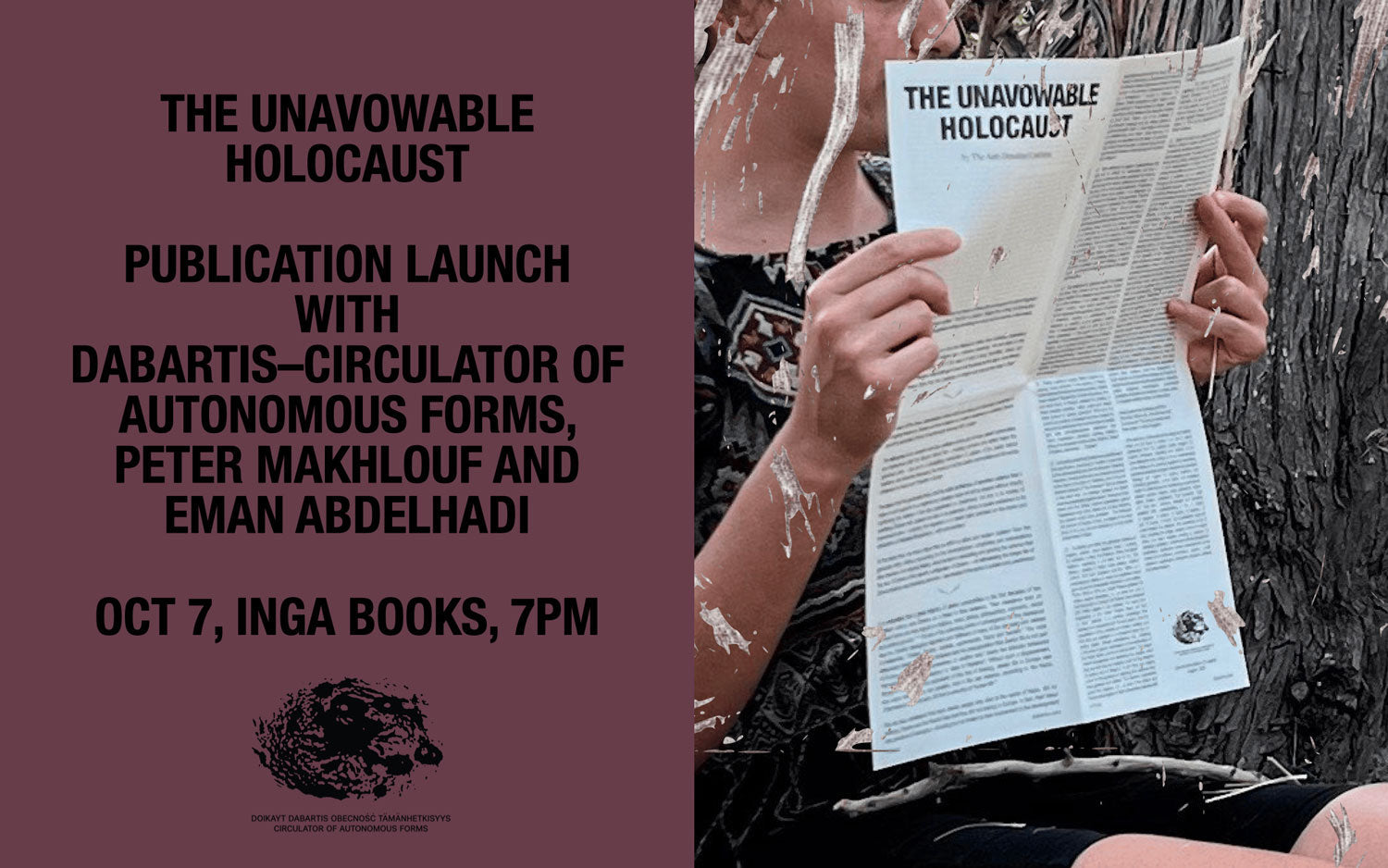
"...fiercly chart[ing] what may be at stake in confronting the planetary scope of the Palestinian Nakba yesterday, today, and tomorrow."
As the genocide in Gaza enters its third year, only escalating in scope and cruelty, we must ask: what is avowed and what is disavowed in our recollection of October 7? Does the day symbolize an insurgency against a ruthless settler-colonial regime? Or, as the imperialist establishment continues to insist, the “greatest massacre of Jews since the Holocaust?”
On October 7, 2025, we gather in Chicago to avow these unavowed, actively erased histories; to refuse the disavowal of the myriad holocausts, of all the “sacrifices” the European political tradition has enacted; to commemorate those who, through various names, languages, cosmologies, and territories, have challenged the world-annihilating catastrophe that is European political modernity.
Just as there is not one single holocaust, there is not only one October 7 at stake here. Our avowals and disavowals of this date concern nothing less than the history of resistance to European colonialism, fascism, and nation-statist supremacy. We might recall that the General Jewish Labor Bund was established on October 7, 1897 in Vilne – an anti-Zionist socialist organization that would rapidly spread across the world. To avow this seemingly coincidental date as part of a trans-historical continuum of resistances is to explode the very frames in which the current discourse is thrown against us.
During the gathering we will circulate two Dabartis publications: The Unavowable Holocaust by the Anti-Denialist Coalition, and Kawkab Hassan On Liberating the Levant by Eman Abdelhadi & M.E. O’Brien. Both works offer guidance and resources for cultivating oppositional spaces of remembrance and action.
The gathering will be facilitated by members of Dabartis alongside the critical theorist Peter Makhlouf and Chicago based writer, organizer, and educator Eman Abdelhadi.
Friday, September 19th
7-9pm
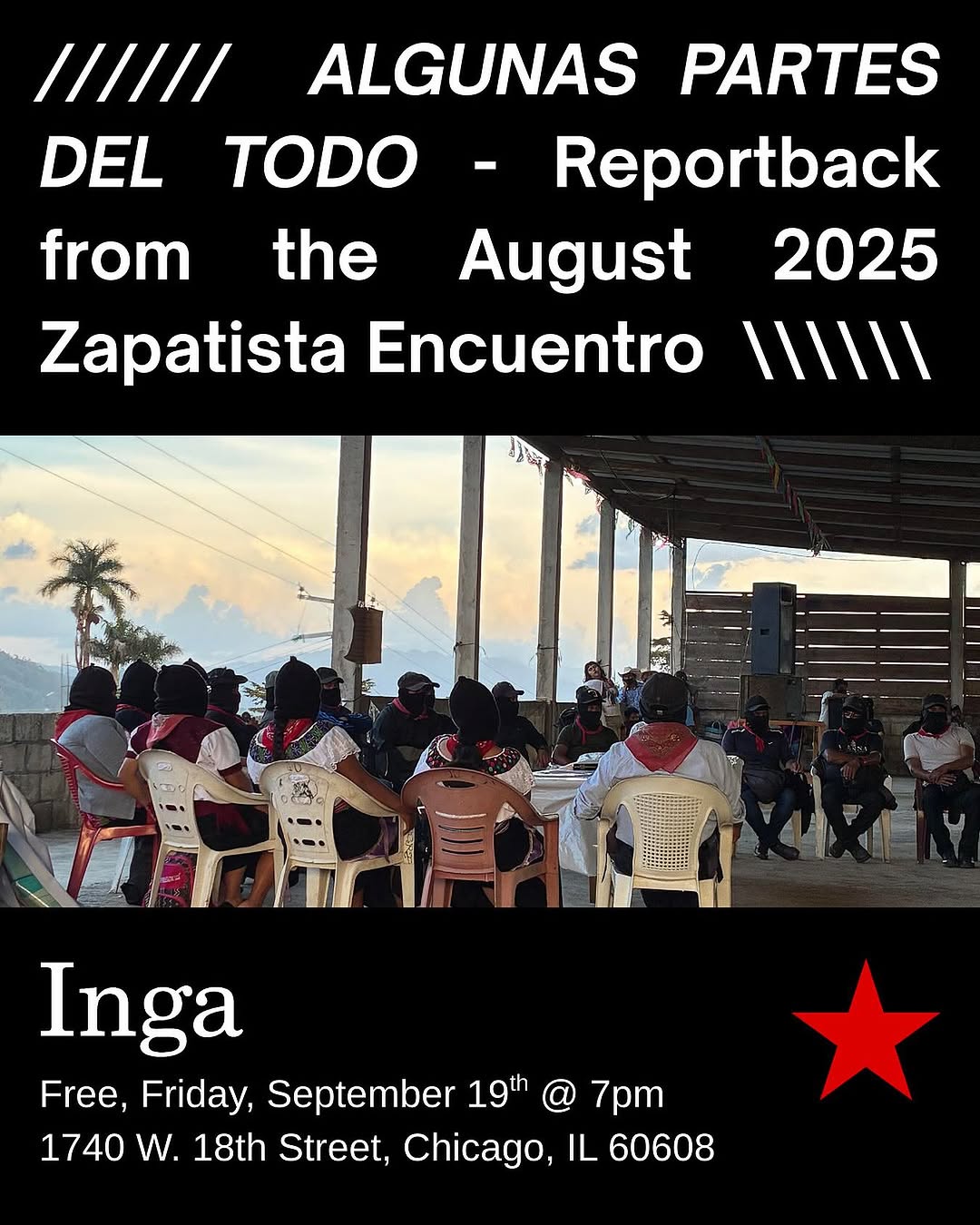
"Will be sharing video, audio, and a presentation, followed by group discussion please come, September 19th at Inga books, 7 pm."
Saturday, June 7th
1–7pm

Come through on Saturday, June 7th to catch INCA Press' Aeron Bergman and Alejandra Salinas while they "pop-up" with a nomadic selection of titles from the imprint's catalog—via decolonization in Bolivia's National Museum of Art by Max Jorge Hinderer Cruz; explorations of early capitalist expropriation of farmers from common held lands through Marx and the USDA; manuel arturo abreu orbiting "art, race, tech, and feelings;" art in neoliberalism; and much more.
At 6pm, INCA will offer a book presentation surrounding their most recent title, KIRKI QHAÑI – Container of Andean Poetics by Elvira Espejo Ayca. A collection of essays and poems/songs situating Aymara ancestrality and Andean Poetics within the ongoing decolonization project, the book is a beautiful archive of Andean traditions and a powerful call to address urgent futures. "KIRKI QHAÑI is in itself a bag of diverging moments and temporalities, a collection of innumerable voices, a container of Andean poetics."
INCA Press publishes experimental and contemporary art books—books as art, books on art, artist’s writings, and interdisciplinary inventions. The goal of INCA Press is to support writing that emerges from visual arts but eschews traditional boundaries between categories of artmaking and discourse. INCA Press supports the experimental work of artists, philosophers, poets and others living between the academy, art, poetry, sociology, and activism. One of the main principles of INCA Press is that art and culture belong to everyone, and all people can participate. Reflecting this goal, INCA donates books to libraries, community centers, prisons, schools, and produces public lectures and workshops.
Thursday, May 8th
7pm

Save the date for: News Night, where 4 journalists have an open-ended conversation around what their latest stories are about and what they are thinking about in the city and globally. Come hungry for a long sandwich.
Thursday, May 8th at 7p.m.
@ Inga (1740 W. 18th Street)
With:
Heather Cherone (WTTW News)
Shannon Heffernan (The Marshall Project)
Keerti Gopal (Inside Climate News)
Jillian Melero (Connect Puerto Rico)
Friday, April 18th
7:30–9pm
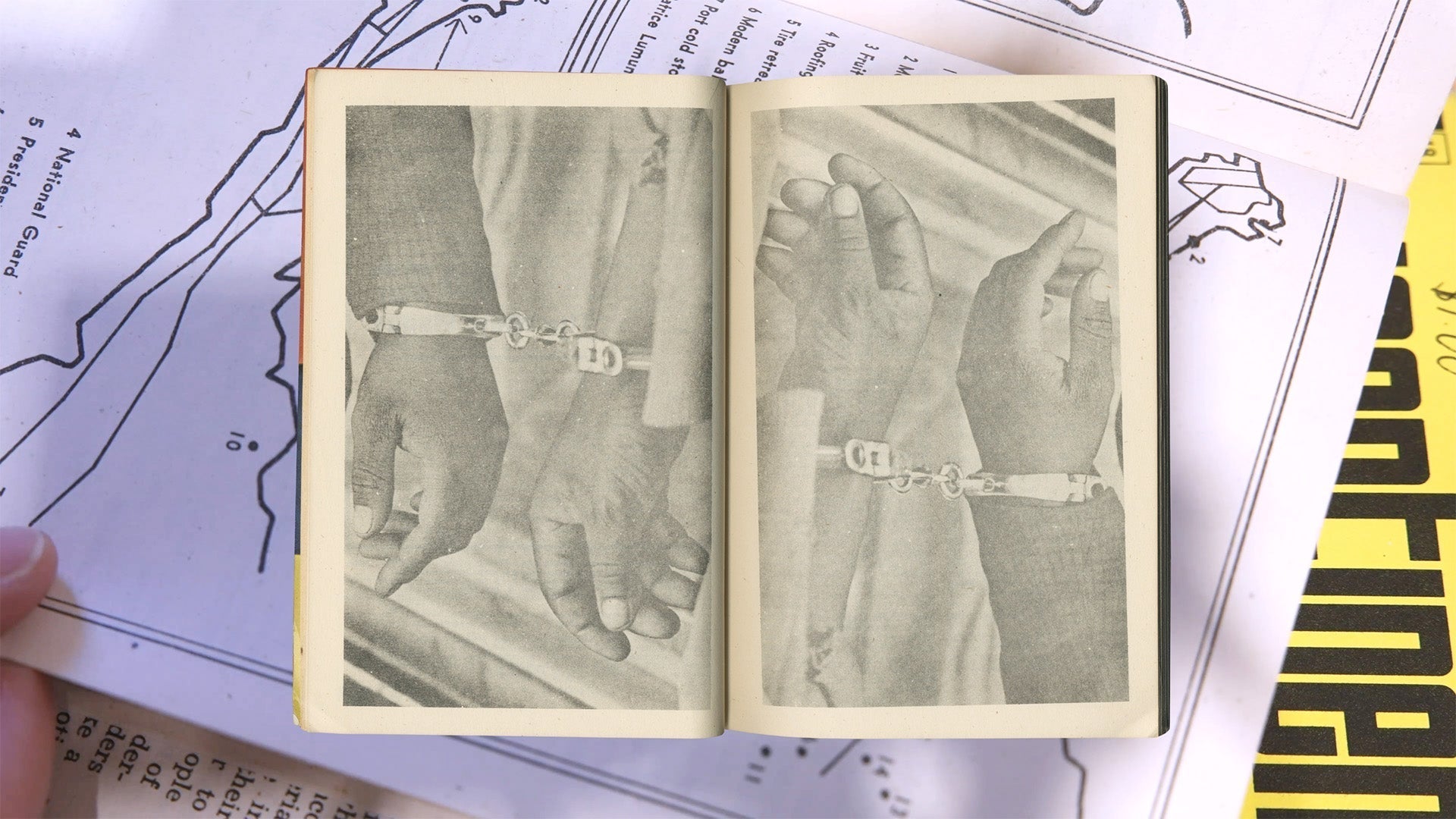
Join us for a screening of Hand Eye: A Study of Tricontinental Photomontage (2023, 20 min) by Bryce Wilner, followed by a discussion with the artist and refreshments.
Friday, April 18th
7:30–9pm
In Hand Eye, Wilner examines the use of photography in Tricontinental, the revolutionary political journal founded in 1967 by Cuba’s Organization of Solidarity with the Peoples of Asia, Africa, and Latin America (OSPAAAL). Recorded at New York’s Interference Archive, this video essay depicts Wilner’s encounter with the material, provides context for OSPAAAL’s prolific publishing operation, and works toward a theory of the group’s signature method of photomontage.
Thursday, April 3rd
6–8pm
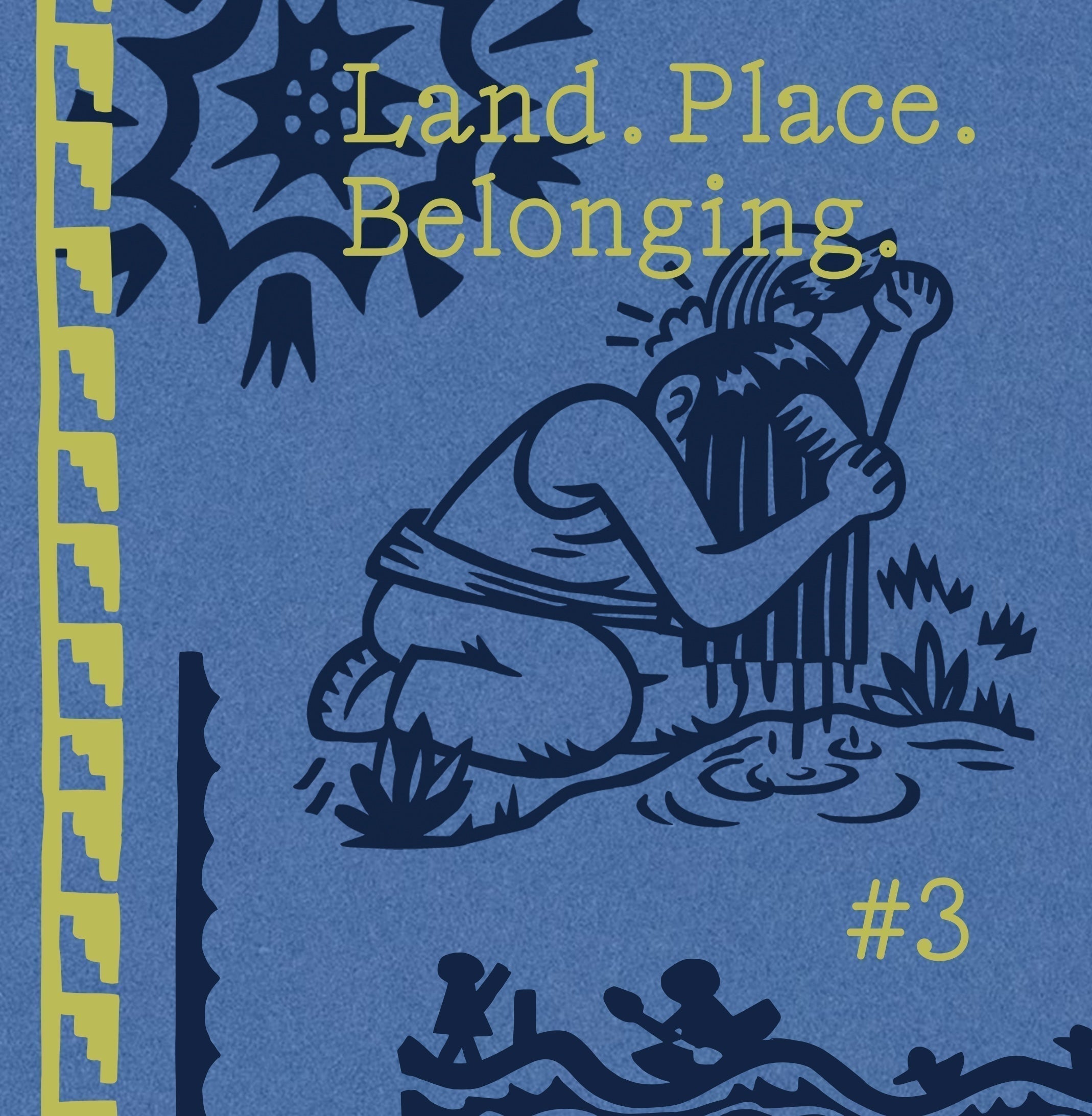
Join us for the release of Land. Place.Belonging. #3 and lively public conversation with provocations from JeeYeun Lee and Muindi Faneuil Muindi.
Land. Place. Belonging. #3 🌀 holds conversations that speak into the technologies of mapping, ritual and storying and their use in remembering and reclaiming both inner and shared territories in these unsettling times.
In L.P.B. issue #3: Philosopher Muindi Faneul Muindi and kinmaker Hyperion Çacatzin Yvaire lo Saga who share forward the technology of their cosmogram, performer and writer Jee Yeun Lee walks boundaried spaces and unearths forgotten stories through listening, Kanienke haka performer and family counselor, boat builder and Marie Lorenz travels urban waterways solo and with others in boats she has built, policy worker and director of the Fresh Water Lab Rachel Havrelock opens political contested waters through sharing their expansive stories, Lindsay Delaronde shares her practices of Embodied Earth Healing, environmental toxicologist Danielle Stevenson leads us into the complexity of applied ecological remediation of contaminated urban land, social practitioner gil lopez holds the line on public green space and social justice activist and first generation immigrant Liza Go grounds to place through regenerating soil through indigenous practices.
Saturday, February 22nd
6-7:30pm

Join us Saturday, February 22nd at 6pm for a screening of 16mm shorts by experimental filmmaker Amy Halpern (1953-2022) and a reading by Laura Paul from her new book “Film Elegy,” published with Prroblem Press.
Laura Paul’s "Film Elegy" is a document of personal loss and the decline of celluloid with echoes between the space of the book and film form. Framed by Paul’s friendship and apprenticeship with the late filmmaker Amy Halpern, the book speaks to the communities and legacies of screen culture.
For over 50 years as an avant-garde filmmaker, commercial cinematographer, technician, programmer, and educator in Los Angeles, Amy Halpern created a body of work with nearly 40 films with an understanding of "cinema as a medium...equally capable of documenting reality and conjuring magic,” according to Sarah Fensom (Film Comment). Halpern's curious cinematic eye evokes otherworldly possibilities within the everyday. Such an intimate practice of looking at people, animals, trees, objects, places, and gestures--for both filmmaker and spectator--becomes a revelation.
Films Include:
Elixir (2012, 7 min, color, silent)
Invocation (1982, 2 min, color, silent)
Peach Landscape (1973, 4.5 min, color, silent)
Fire Belly (2021, 3 min, color, silent)
Chabrot (2022, 3.5 min, bw, sound)
3-Minute Hells (2012, 14 min, color, sound)
Ma Sewing (2021, 1.5 min, color, silent)
Jane Looking (2020, 2 min, color, silent)
Palm Down (2012, 6 min, color, silent)
Total run time: ~ 45 min
All films projected on 16mm by Ben Creech. Prints courtesy of Canyon Cinema.
About the author:
"Laura Paul is a writer and artist who has been published in The Brooklyn Rail, Los Angeles Review of Books, The Comics Journal, and other outlets. Her work has been exhibited at the Armory Center for the Arts, Other Places Art Fair, L.A. Zine Fest, and West Hollywood Book Fair. She earned her B.A. in Comparative History of Ideas from the University of Washington, where she was named a Mary Gates Scholar in the Arts and Humanities, and her M.A. in Cinema and Media Studies from UCLA, where she received the Gilbert Cates Fellowship for Artistic and Academic Merit. Her book, Film Elegy, was released in October 2024."
____
Additional films from Amy Halpern's singular filmography will be shown in Chicago as part of "Palm Down: The Films of Amy Halpern" series with screenings on Friday, February 21st at the Block Museum and Sunday, February 23rd by Tone Glow programmer Joshua Minsoo Kim at Elastic Arts.
Saturday, November 9th
3:30-5pm
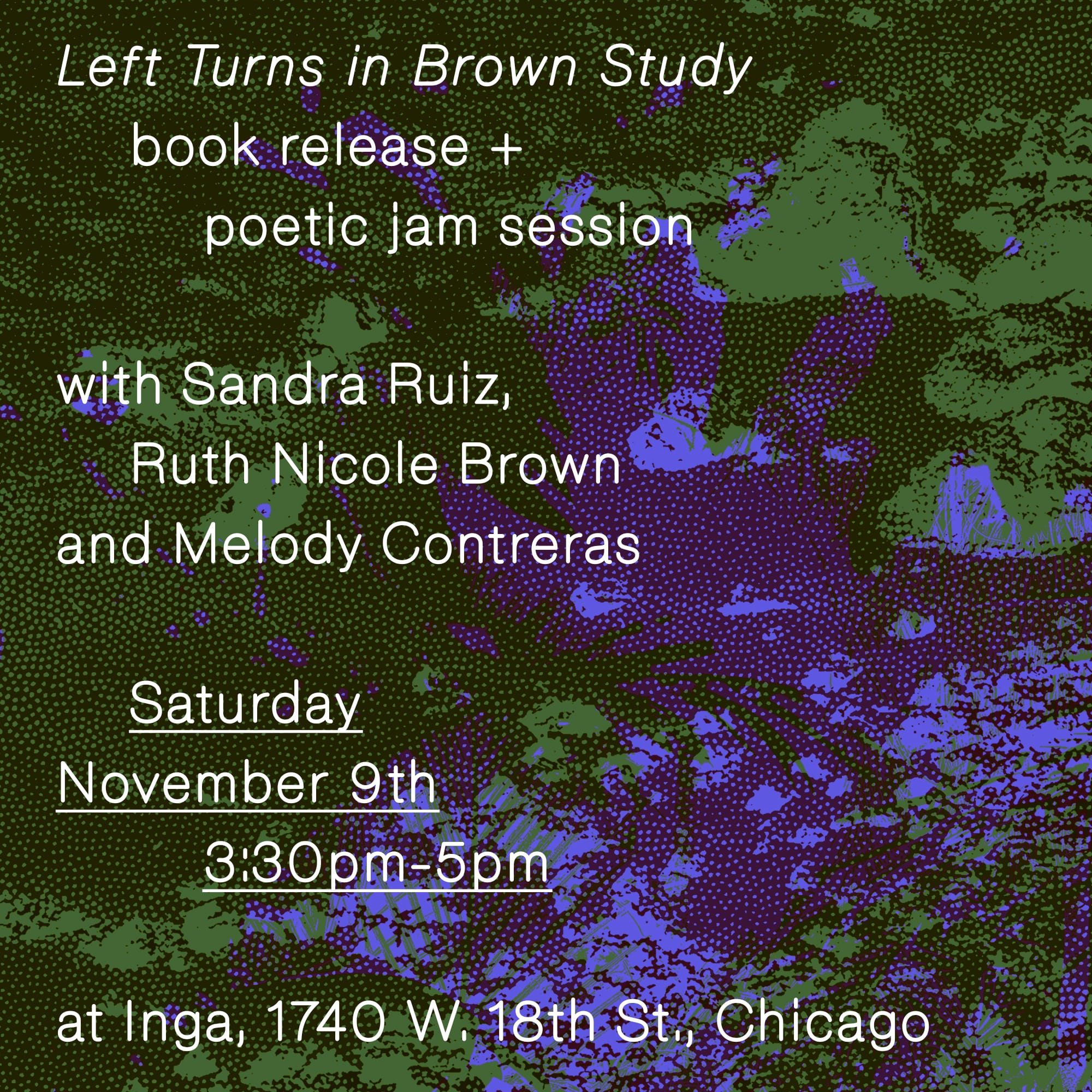
🐚 🎛 The three will be in conversation surrounding and read from/around Ruiz's book, "crucial for all those who theorize minoritarian literary aesthetics and think through utopia, queer possibility, and the entwinement of forms," including an open dialogue throughout.
"In Left Turns in Brown Study Sandra Ruiz offers a poetic-theoretical inquiry into the interlacing forms of study and mourning. Drawing on Black and Brown activism and theory, Ruiz interweaves poetry, memoir, lyrical essay, and vignettes to examine study as an emancipatory practice. Proposing “brown study” as key for understanding how Brownness harbors loss and suffering along with the possibility for more abundant ways of living, Ruiz invites readers to turn left into the sounds, phrases, and principles of anticolonial ways of reading, writing, citing, and listening. In doing so, Ruiz engages with a panoply of hauntings, ghosts, and spectral presences, from deceased teachers, illiterate ancestors, and those lost to unnatural disasters to all those victims of institutional and colonial violence. Study is shared movement and Brownness lives in citation. Conceptual, poetic, and unconventional, this book is crucial for all those who theorize minoritarian literary aesthetics and think through utopia, queer possibility, and the entwinement of forms."
Saturday, November 2nd
5:30-7pm

Alejandra will talk about the background of the composers found in the book and play sound examples to make Latin American music history experienceable. 🎛 🌀 ¡Nos vemos!
Friday, November 1st
5:30-7pm

You are welcome to arrive earlier during the open hours, as of 1pm, on Nov. 1st to browse through these publications, have a drink, along with other books at Inga. ☕️ We hope to see you there!
Friday, October 11th
6-9pm
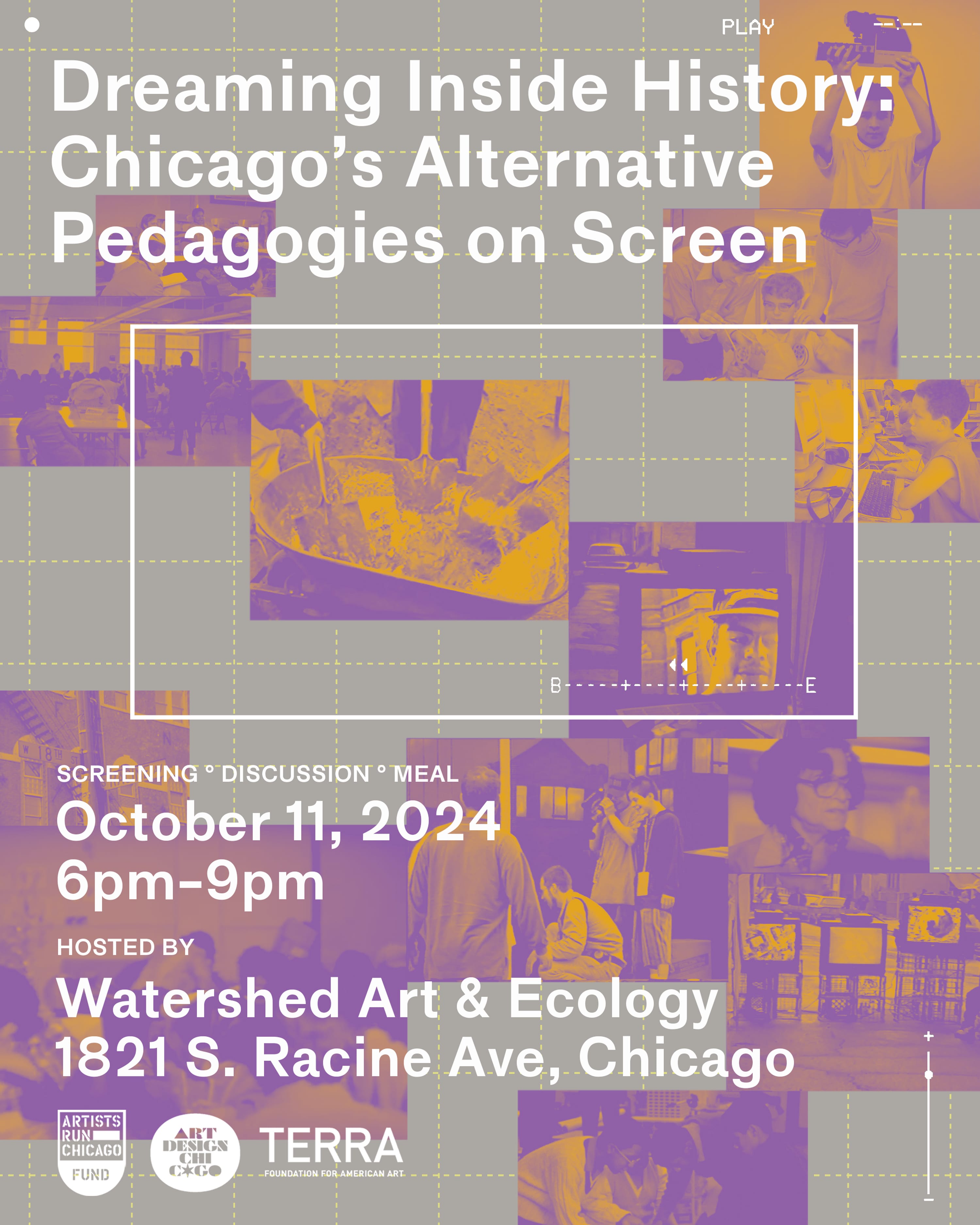
A film screening, discussion, and shared meal which unpacks and revisits histories of alternative art and design education, in and outside schools, across several decades of Chicago history. Featuring works from Chicago Metro School, an autonomous CPS high school “without walls” founded in the 1970s; the Stockyard Institute, a DIY art school and radio station for grassroots community organizing founded in 1995 in the Back of the Yards neighborhood; Street-Level Youth Media, a collective amplifying youth voice, equitable access to new media, and civic awareness; Video Machete, founded in 1994 as a collective of activists, students, and media-based artists running youth media workshops across the city; and Eleanor Boyer & Karen Peugh’s La Maestra (1984), a look at Pilsen’s Maria Luisa Michel Almonte, a flower shop-based community arts and crafts teacher. Including newly-digitized footage, the featured work shows students and teachers (sometimes indistinguishably) asserting what it looks like to practice art and design education in an alternative context, and why taking such pedagogies to the margins of institutionality is meaningful for some and necessary for others. Join us for a conversation and food after the screening alongside the presence of students, teachers, and filmmakers involved. Programmed by Inga, a Pilsen bookshop, and hosted by Watershed, a space for thinking across and with art & ecology.
This program is supported by Hyde Park Art Center’s Artists Run Chicago Fund in partnership with Art Design Chicago, a citywide collaboration initiated by the Terra Foundation for American Art that highlights the city’s artistic heritage and creative communities.
Sunday, September 22
1-4pm
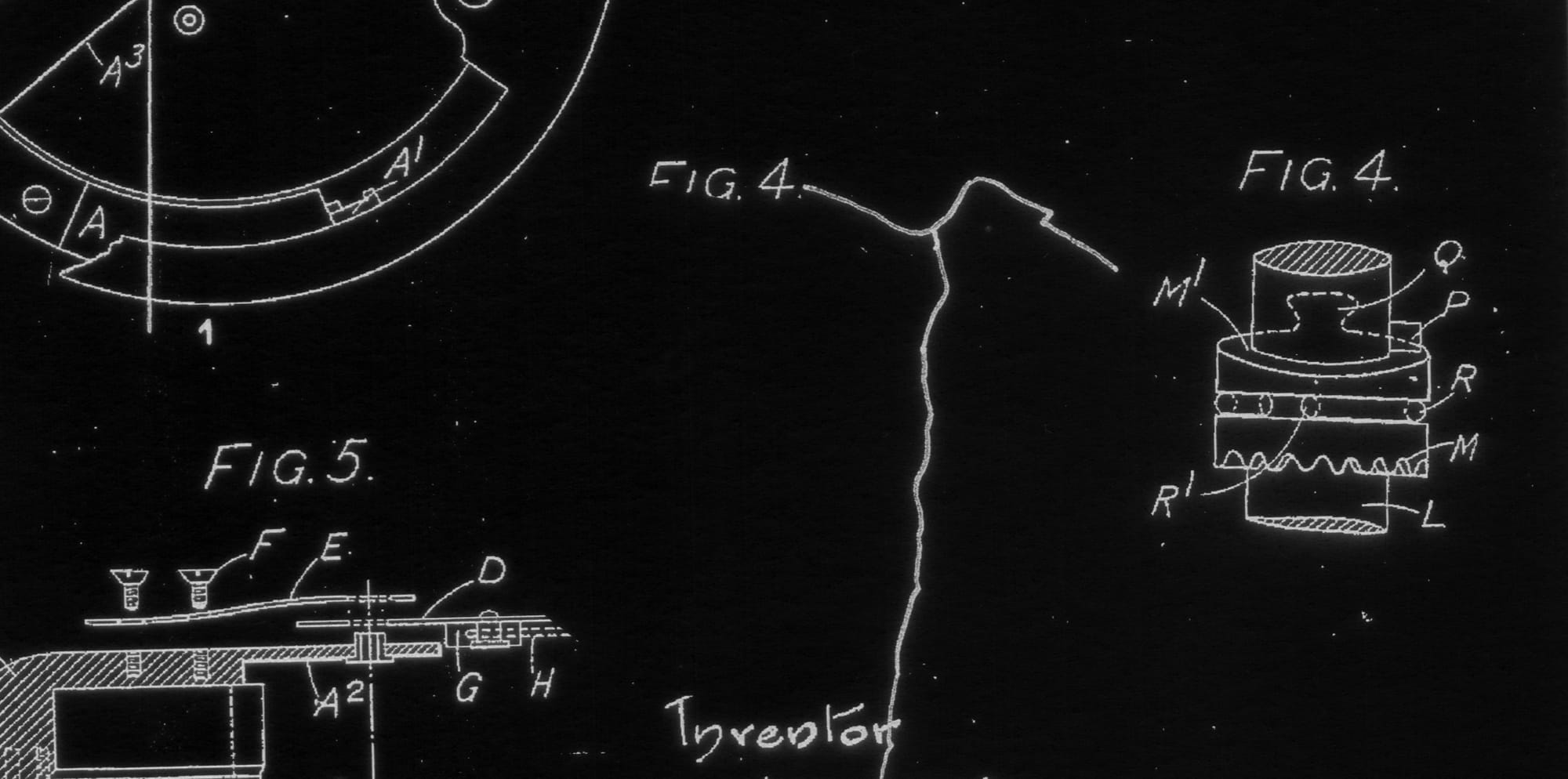
Thursday, September 19th
6-8pm
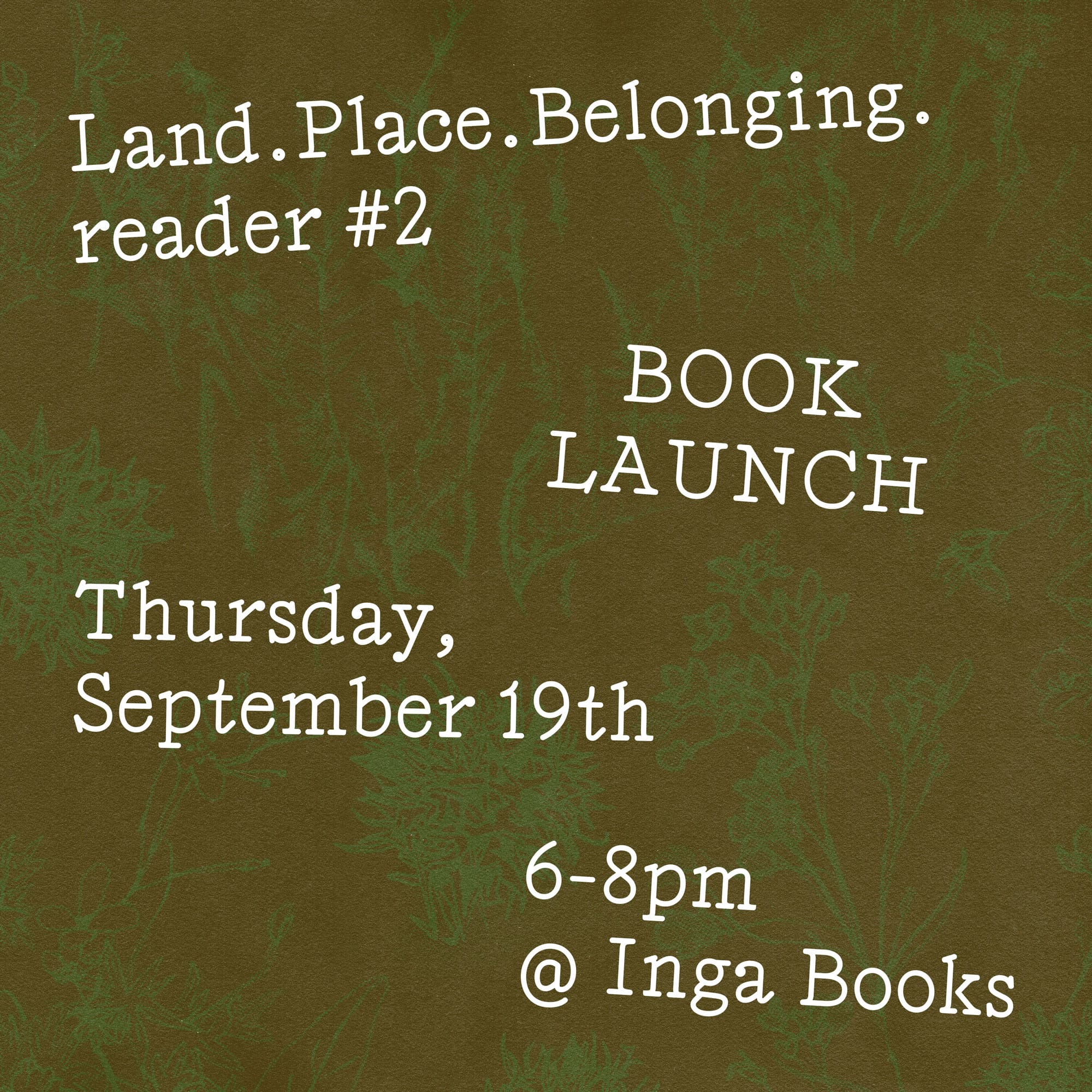
The contributors In Land.Place.Belonging. #2 are:
🌱 Lydia Cheshewalla: indigenous artist living and working in motion throughout the Great Plains ecoregion engages with place-based relationship. 🌱 CA Conrad: somatic ritual poet and author shares their conversations with animals and ghosts and shares some of their recent poetry. 🌱 Csilla Hodí: embodied public space researcher and mycologist who talks to practices thinking with fungi in outsider & migrating contexts. 🌱 Elijah Rodriguez: speaks to the heart centered work of listening deeply to plants and community to guide in how he responds to and stewards urban land. 🌱 Phera Singh: queer, mixed, Punjabi & Sikh shares their reciprocal relationship with wild willow through the handcraft of basketry. 🌱 Marina ‘Heron’ Tsaplina: interdisciplinary eco-puppetry artist, writer and disability culture activist who stories her work with forests and soil. 🌱 Adam Grossi: writer, painter and teacher of embodied spirituality and psychological stability speaks to the inner instability of opening to authentic consciousness. 🌸 Illustrations throughout the book (and on this post) by Fiona Cook
Monday, September 2nd
6pm

2024 marks the 40th anniversary of the Bhopal gas leak disaster, which remains the worst industrial disaster in history. For nearly four decades, gas-exposed communities in Bhopal continue to face significantly higher mortality rates, various diseases, neurological disorders, and two generations of birth defects. Today, well over 150,000 people in Bhopal are battling chronic illnesses that are related to their own exposure or that of their parents, and 500,000 lives remain physically and economically harmed from the disaster. These survivors will present an account of how gas-exposed communities in Bhopal have persisted for 40 years, treating illness and documenting the continued environmental pollution and damage to health faced in their communities. We will also discuss how the fight for environmental justice in Bhopal is fundamentally linked to the fight for environmental justice in Chicago, and how international solidarity can empower our movements for liberation.
Saturday, July 27
7-9pm
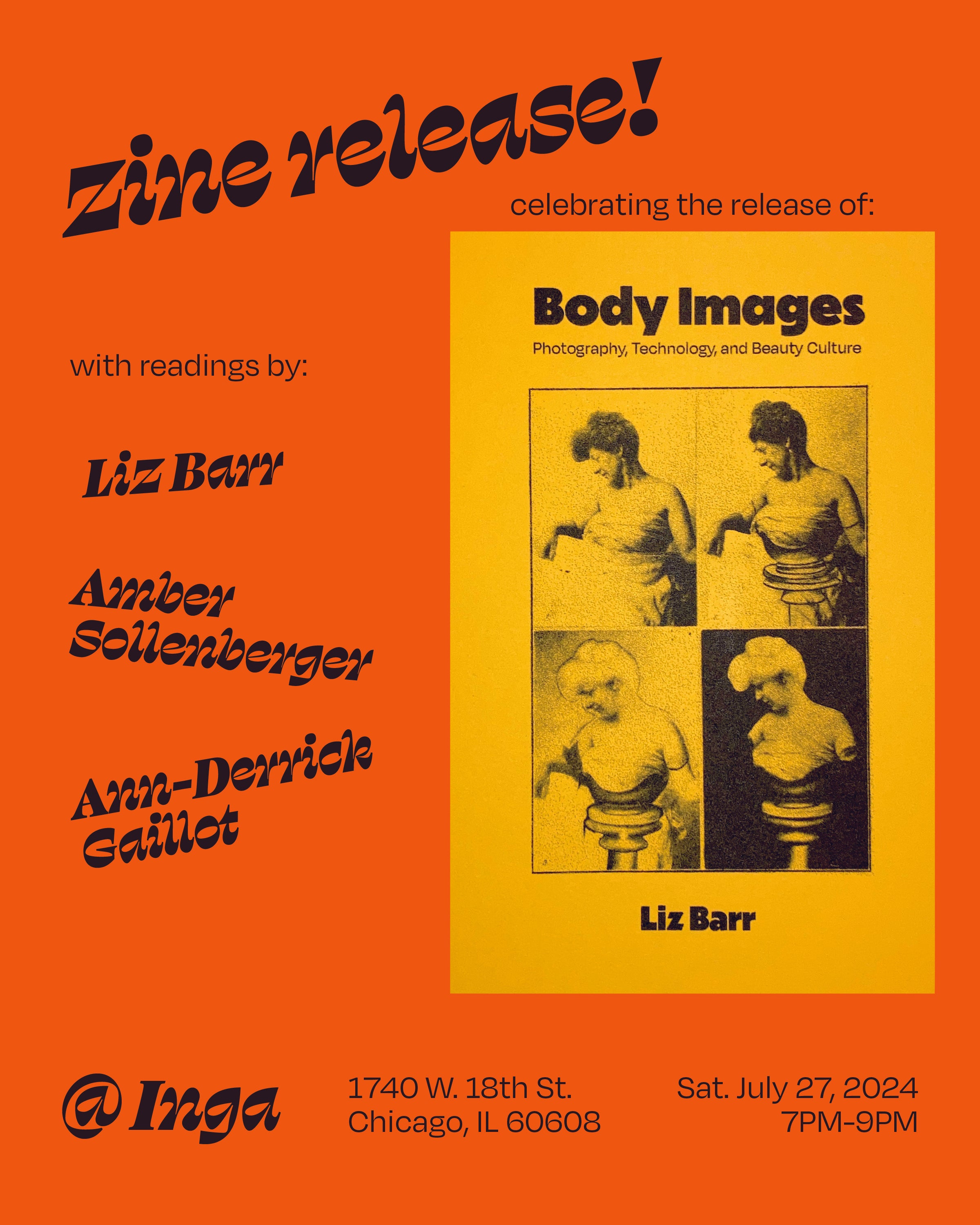
"From the manual retouching processes of the 19th century to the instantaneous beauty filters of the 21st century, how has photo-editing shaped the way we see ourselves and each other? Do manipulated photos warp our perception of reality? Do un-manipulated photos exist? Has the ubiquity of digital photography and publishing platforms exacerbated our insecurities, or helped to expand our ideas of beauty? Body Images grapples with these questions while providing historical context to our contemporary anxieties."
Readings by @lizbarrrr, @solemnburger & @adgzines ✨🧃 light refreshments will be provided 😷 masks are required (while not actively eating or drinking), and there will be air purifiers in the space
Tuesday, May 7th
6-10pm
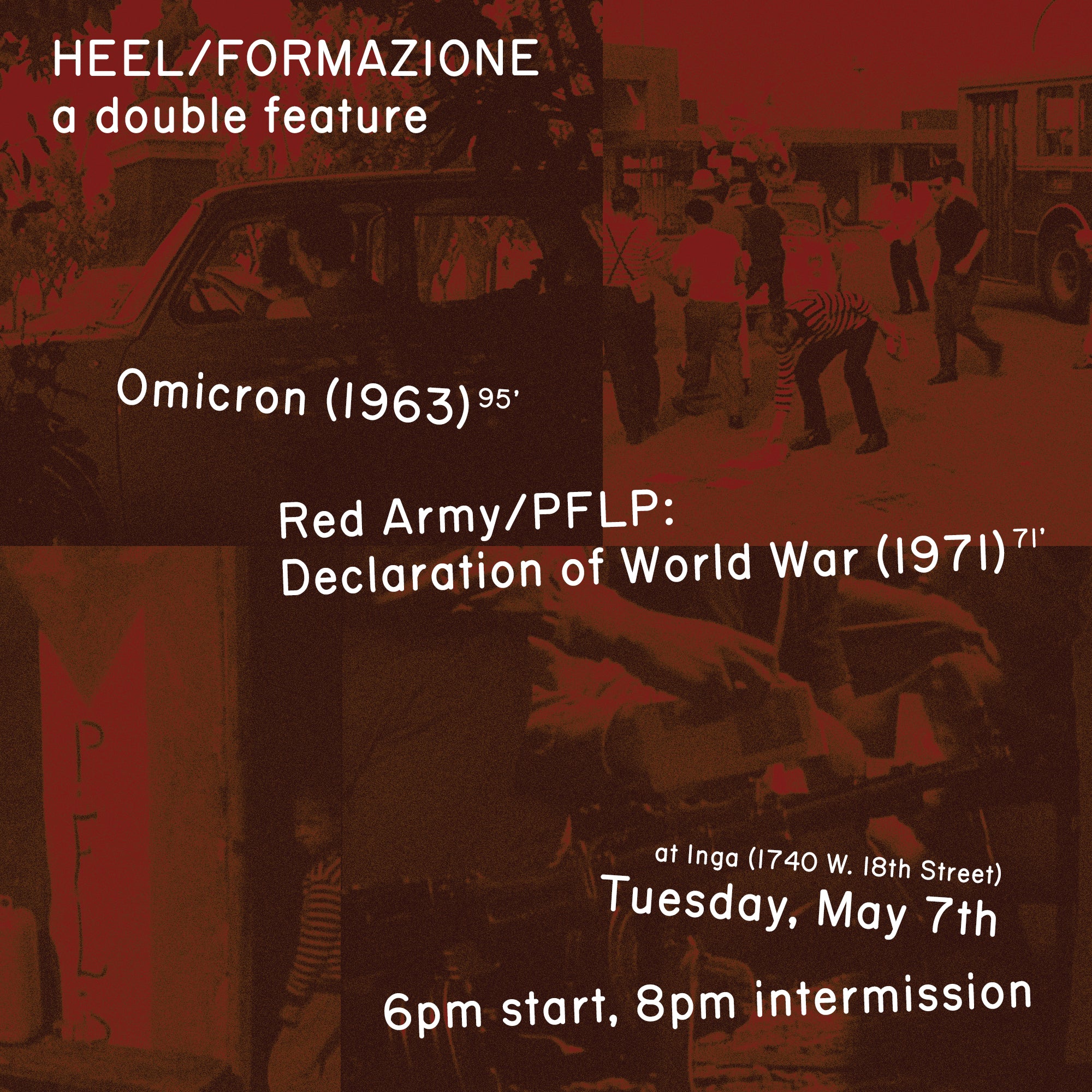
Showing are OMICRON (1963)—between ironic science fiction, comedy, surrealism, television investigation, and journalism: a tale of "alienation" via the extraterrestrial possession of a factory worker's body—and RED ARMY/PFLP: DECLARATION OF WORLD WAR—a propaganda newsreel film promoting the Palestinian resistance via the the everyday banality of military training and slow-paced preparation exercises
for imminent battle. In both films, reading (on- and off-screen) plays a pivotal role.
Organized in collaboration with Will Lee. 🇵🇸🧰🛠🦠 We'll start at or shortly after 6pm, with an intermission at 8pm before the second film. Drinks on-site, BYOP 🍿
Saturday, April 27
6-7:30pm
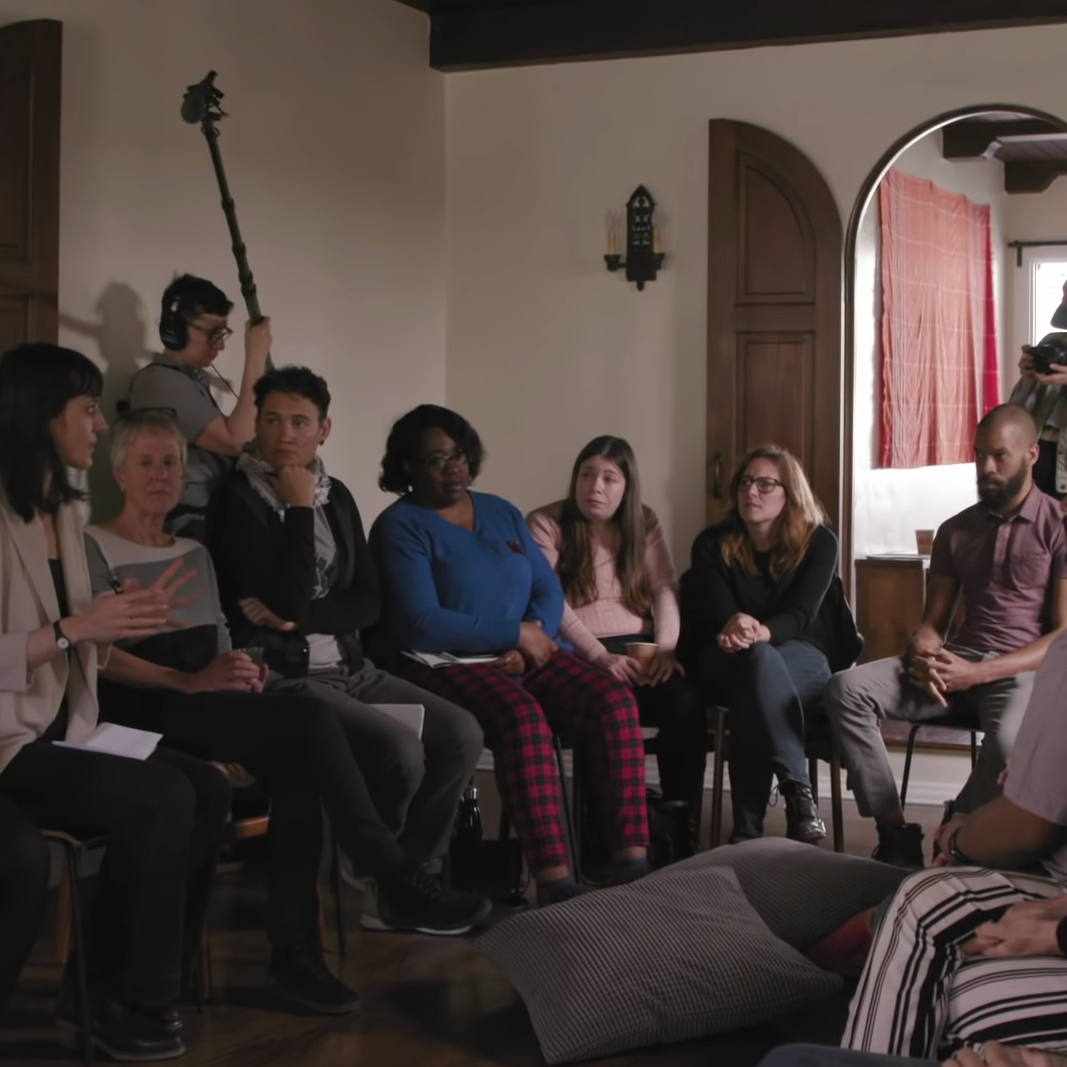
Come through to learn more about the work of the Debt Collective, the strides being made toward student load debt abolition, and how you can get involved.